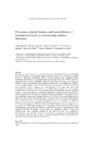Mostrar o rexistro simple do ítem
Prevalence, clinical features, and natural history of incidental clinically non-functioning pituitary adenomas
| dc.contributor.author | Iglesias, Pedro | |
| dc.contributor.author | Arcano, Karina | |
| dc.contributor.author | Triviño, Vanessa | |
| dc.contributor.author | García-Sancho, Paula | |
| dc.contributor.author | Díez, Juan José | |
| dc.contributor.author | Villabona, Carles | |
| dc.contributor.author | Cordido, Fernando | |
| dc.date.accessioned | 2018-10-29T12:19:23Z | |
| dc.date.available | 2018-10-29T12:19:23Z | |
| dc.date.issued | 2017-07-31 | |
| dc.identifier.citation | Iglesias P, Arcano K, Triviño V, García-Sancho P, Díez JJ, Villabona C, et al. Prevalence, clinical features, and natural history of incidental clinically non-functioning pituitary adenomas. Horm Metab Res. 2017;49(9):654-659 | es_ES |
| dc.identifier.issn | 0018-5043 | |
| dc.identifier.uri | http://hdl.handle.net/2183/21213 | |
| dc.description.abstract | [Abstract] The objective of the study was to assess the prevalence and clinical features of incidentally discovered clinically non-functioning pituitary adenoma (CNFPA) and to analyze its natural history. A multicenter retrospective study in patients diagnosed with incidental CNFPA periodically followed-up in 3 specialized neuroendocrinology units from 1992 to 2015 was performed. Out of a total of 189 CNFPA patients, 57 cases (30.1%; 29 women; age at diagnosis 55.8±16.7 years) were incidental. Most patients (n=55, 96.5%) were diagnosed by magnetic resonance imaging (MRI). A sum of 71.9% (n=41) were macroadenomas; 2 of them (3.5%) were giant adenomas (≥4 cm). Patients with macroadenomas were older than those with microadenomas (59.5±16.7 vs. 46.4±18.1 years, p=0.007). Macroadenomas were more common in men (85.7% vs. 58.6%, p=0.023). Twenty-eight patients (49.1%) showed suprasellar extension; of these, 19 were accompanied by chiasmatic compression. Hypopituitarism was present in 14 (24.6%) patients; which was partial in 13 patients (22.8%) and complete in one patient (1.8%). The gonadal axis was the most frequently affected (n=13, 22.8%). Twenty four patients (42.1%) underwent surgery. Of the non-operated patients, 26 patients could be evaluated morphologically after a median follow-up of 15.5 months (interquartile range, 5.7–32.7 months). No significant changes were found in the maximum tumor diameter at the end of follow-up (1.2±0.6 vs 1.2±0.7 cm). The majority of CNFPAs evaluated (n=23, 88.5%) did not show any changes in size. In 2 cases (7.7%) tumor size decreased, and in one patient (3.8%) increased. In our series of CNFPA patients, approximately one-third were incidental. These tumors were diagnosed by MRI preferably from the 5th decade of life without sex predilection. Most of them were macroadenomas, more commonly diagnosed in men and at an older age, compared to microadenomas. The suprasellar extension with chiasmatic compression and hypopituitarism were frequent at diagnosis. Most of the non-operated incidental CNFPAs remain with stable tumor size over time, growth being an unusual event. | es_ES |
| dc.description.sponsorship | Insituto de Salud Carlos III; PI16/00884 | es_ES |
| dc.language.iso | eng | es_ES |
| dc.publisher | Thieme | es_ES |
| dc.relation.uri | http://dx.doi.org/10.1055/s-0043-115645 | es_ES |
| dc.subject | Pituitary incidentaloma | es_ES |
| dc.subject | Clinically non-functioning pituitary adenoma | es_ES |
| dc.subject | Retrospective | es_ES |
| dc.subject | Multicenter study | es_ES |
| dc.title | Prevalence, clinical features, and natural history of incidental clinically non-functioning pituitary adenomas | es_ES |
| dc.type | info:eu-repo/semantics/article | es_ES |
| dc.rights.access | info:eu-repo/semantics/openAccess | es_ES |
| UDC.journalTitle | Hormone and Metabolic Research | es_ES |
| UDC.volume | 49 | es_ES |
| UDC.issue | 9 | es_ES |
| UDC.startPage | 654 | es_ES |
| UDC.endPage | 659 | es_ES |
Ficheiros no ítem
Este ítem aparece na(s) seguinte(s) colección(s)
-
GI-FENM - Artigos [109]






